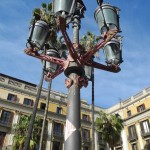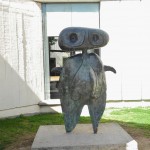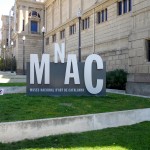see Antonio Gaudi Gaudi is one of the big draws to this amazing city. I’ve created a page just for the Gaudi sites we were able to visit.
Barcelona – Some glimpses of one of the world’s great cities – and the busiest cruise ship port.
My YouTube clips of: View from our Gaudi’s Nest apartment; Elevator to our Apartment; Street Entertainment
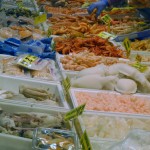 Mercat Santa Caterina is one of several markets found throughout Barcelona. This one is located in the old part of the city. It is not near as well known as the Boqueria, which is located on the famous Ramblas – but is much less ‘touristy’ with a local feel and flare.
Mercat Santa Caterina is one of several markets found throughout Barcelona. This one is located in the old part of the city. It is not near as well known as the Boqueria, which is located on the famous Ramblas – but is much less ‘touristy’ with a local feel and flare.
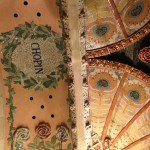 The Palau de la Musica de Cataluyna is certainly a terrific example of the Modernista architectural style that so typifies Barcelona. The style – and certainly the Palau – uses nature themes – trees, leaves, flowers, animals – as the basis. It is also known for avoiding straight lines and the use of smashed ceramic tiles. The architect of this building was Lluís Domènech i Montaner.
The Palau de la Musica de Cataluyna is certainly a terrific example of the Modernista architectural style that so typifies Barcelona. The style – and certainly the Palau – uses nature themes – trees, leaves, flowers, animals – as the basis. It is also known for avoiding straight lines and the use of smashed ceramic tiles. The architect of this building was Lluís Domènech i Montaner.
Barri Gotico – Barcelona’s old city. We took a Trixie cab ride through these narrow streets. Lots of things to see and do. We went on a Sunday, and were treated to some special sights. There was the Sardana dance in front of the Cathedral. the Sardana is an ancient Catalonian custom that shows the togetherness and determination of this proud people. And then there were the casteleers. These are clubs that continue the Catalonian custom of building human pyriads (or castles). Our Trixie driver was Omar. Omar was from Morroco. Good English – great guide.
My YouTube vidoes of: Santa Maria del Pi; the cathedral; cathedral 2, Sardana Practice, Sardana 1; Sardana 2; Casteleers – Red; Castleleers – Blue; End of our Trixie Cab Ride.
Montujic – Montujic, mount of the Jews. Lots to see and do here. There’s the MNAC art museum, the Joan Miro art museum, Poble Espanyol (Spanish village) – among many other sights.
MNAC – The National Arts Museum of Cataluyna. Interesting museum, with plenty of works by the greats. But it is best known for its efforts to preserve the arts that adorned churches throughout the region. Many were being torn down – so they were removed and displayed. Sometimes, alnost the entire church interior was reconstructed.

